Ch9-Intellectual and Neuropsychological Assessment
1/34
There's no tags or description
Looks like no tags are added yet.
Name | Mastery | Learn | Test | Matching | Spaced |
|---|
No study sessions yet.
35 Terms
What is a hallmark of clinical psychology since its origin?
Measuring cognitive performance:
—intelligence,
-achievement
-neuropsychological functioning
intelligence tests
Psychological tests that measure a client’s intellectual abilities
Achievement tests
Type of standardized tests used to measure how much students have learned in specific, clearly defined content areas, including but not limited to reading, mathematics, science, and social studies
neuropsychological tests
Psychological tests that focus on issues of cognitive or brain dysfunction, including the effects of brain injuries and illnesses
Classic Theories of Intelligence
What it intelligence?
Aptitude or intellect;
the exact definition has long been a subject of debate among psychologists and may or may not include the speed of mental processing, sensory capacity, abstract thinking, imagination, adaptability, capacity to learn through experience, memory, reasoning, or inhibition of instinct and problem-solving abilities. These theories often emphasize different aspects of what constitutes intelligence, such as emotional intelligence, multiple intelligences, and general intelligence.
Charles Spearman: Intelligence Is One Thing
Classic Theories of Intelligence
In the early 1900s, Charles Spearman proposed that intelligence is a single characteristic called "g" for general intelligence.
This "g" represents overall intellectual ability and is based on correlations across various abilities. While he recognized specific abilities ("s"), he believed they had a minor role compared to "g". Essentially, to Spearman, intelligence was one main factor.
Louis Thurstone: Intelligence Is Many Things
Classic Theories of Intelligence
Louis Thurstone opposed Spearman's theory of a single intelligence factor. Using multiple-factor analysis Thurstone identified
several independent factors of intelligence:
- verbal comprehension,
-numerical ability
-spatial reasoning.
He argued that intelligence consists of many distinct abilities, and one's capability in one area doesn't predict capability in another.
Hierarchical model of intelligence:
A model of intelligence in which specific abilities (“s”) play an important role but are all at least somewhat related to one another and to a global, overall, general intelligence (“g”)
***Spearman and Thurstone reached a compromise with a hierarchical model of intelligence: specific abilities ("s") are important but relate to an overarching general intelligence ("g").

Contemporary Theories of Intelligence
Contemporary intelligence theories have evolved since Spearman and Thurstone's times.
James Cattell introduced fluid (problem-solving) and crystallized (accumulated knowledge) intelligence.
John Carroll presented a three-stratum model with a general "g", eight broad factors, and over 60 specific abilities.
This was combined with Cattell’s theory, forming the Cattell-Horn-Carroll (CHC) theory, which comprises 16 broad cognitive abilities and 80 specific ones.
Modern intelligence tests: such as the Wechsler, Stanford-Binet, Woodcock-Johnson, and Kaufman Assessment Battery, reflect these understandings by assessing both general and specific abilities.
Drawing an analogy with multisport athletes, like Michael Jordan, there's debate on whether one has a general athletic ability or multiple specific talents. Jordan's basketball prowess and baseball challenges highlight the complexity of defining ability.

Who is John Carroll?
A contemporary leader in the study of intelligence who has proposed the three-stratum theory of intelligence
three-stratum theory of intelligence
A contemporary theory that intelligence operates at three levels: a single "g" at the top, 8 broad factors immediately beneath "g," and more than 60 highly specific abilities beneath these broad factors

James Cattell
A leading figure in the study of intelligence who proposed separate fluid and crystallized intelligences
Fluid intelligence
The ability to reason when faced with novel problems
Crystallized intelligence
The body of knowledge one has accumulated as a result of life experiences
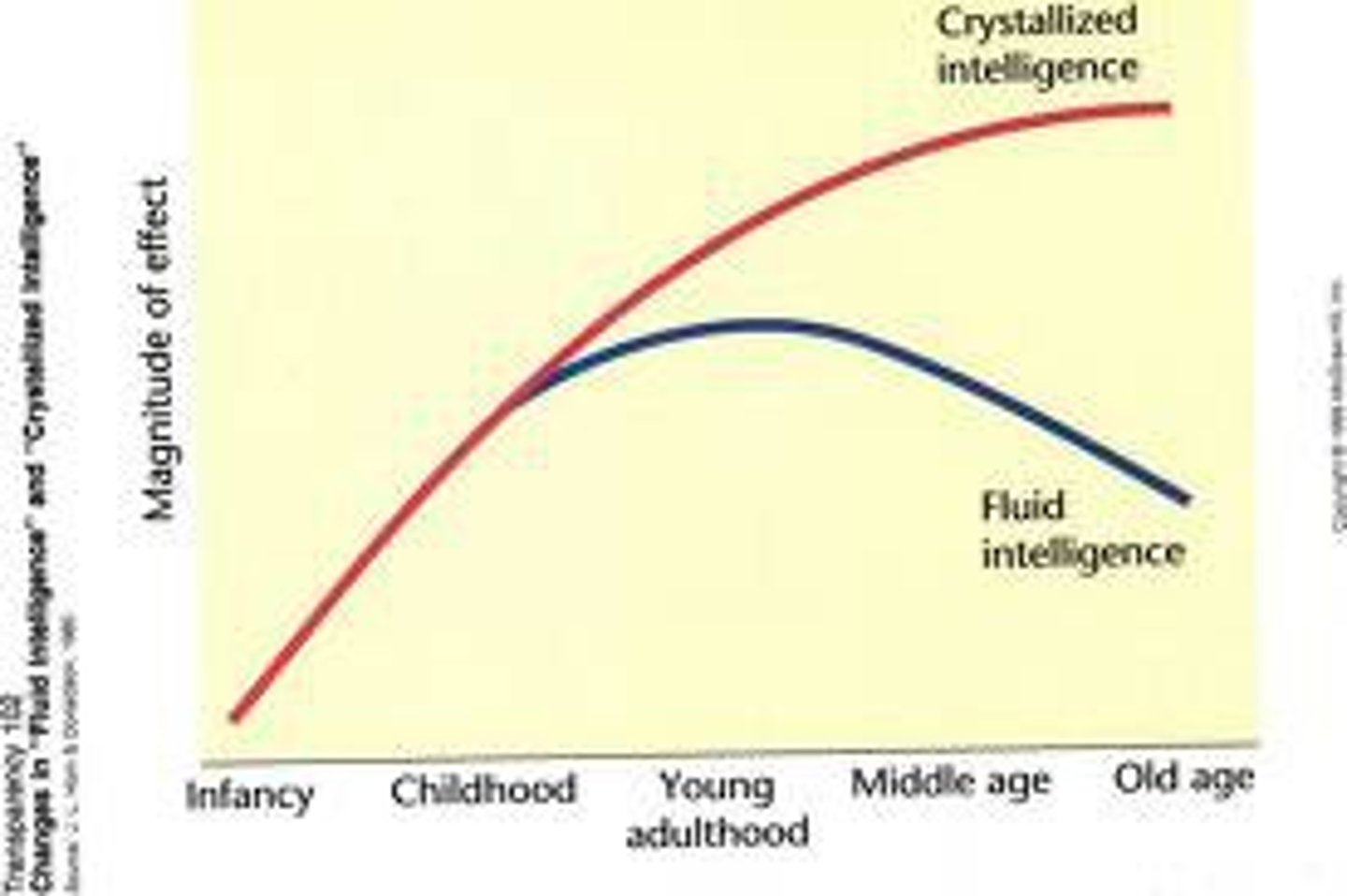
Cattell-Horn-Carroll (CHC) theory of intelligence:
A theory of intelligence that combines elements of Cattell’s, Horn’s, and Carroll’s theories in which abilities are arranged as broad and specific factors, and which has become prominent in recent years

Wechsler Intelligence Tests
Origin and Prevalence: David Wechsler's intelligence tests, developed in the early 1900s, are the most widely used intelligence tests for their respective age groups. There are three primary versions:
Wechsler Adult Intelligence Scale—Fourth Edition (WAIS-IV)
Wechsler Intelligence Scale for Children—Fifth Edition (WISC-V)
Wechsler Preschool and Primary Scale of Intelligence—Fourth Edition (WPPSI-IV)
Coverage: The three Wechsler intelligence tests cover almost the entire lifespan and are distinct, with each having its own kit, manuals, and answer sheets.
Structure and Scores:
They yield a full-scale intelligence score, 4-5 index scores, and multiple subtest scores.
They employ a hierarchical model of intelligence with a general intelligence score ("g") and more specific ability scores ("s").
Administration:
Administered one-on-one and face-to-face.
They are not group tests or purely paper-pencil tests but require interpersonal interaction.
Each subtest lasts between 2-10 minutes and includes items of increasing difficulty.
Categories and Factors:
Originally, Wechsler's tests were divided into verbal and performance (nonverbal) subtests.
Modern editions recognize four to five factors, informed by factor analyses, that reflect specific cognitive abilities.
Normative Data:
They have extensive normative data (around 2,000 people) that closely match U.S. Census data.
IQ scores (both full-scale and index) have a mean of 100 with a standard deviation of 15. Subtest scores have an average score of 10 with a standard deviation of 3.
Interpretation:
Assessors start with the full-scale IQ, then move to index scores, and then to subtest scores, finally noting behavioral patterns or inconsistencies.
Psychometric Properties:
They possess strong reliability and validity.
Applications:
Used for various clinical applications, including intellectual developmental disorders, developmental delays, educational planning, giftedness evaluations, and more.
Digital Transformation:
The Wechsler tests were introduced on a digital platform, the Q-interactive system, allowing administration and scoring on tablets, such as iPads. This digital approach has both pros and cons and has led to mixed results in research comparing it to

full-scale intelligence score:
A feature of most contemporary tests of intelligence indicating overall or general level of intelligence

index scores:
How many and name index scores?
A feature of most contemporary tests of intelligence indicating intellectual ability in one of a small number of broad areas
Verbal Comprehension Index(VCI)—a measure of verbal concept formation and verbal reasoning
Perceptual Reasoning Index(PTI)—a measure of fluid reasoning, spatial processing, and visual-motor integration
Working Memory Index(WMI)—a measure of the capacity to store, transform, and recall incoming information and data in short-term memory
Processing Speed Index (PSI)—a measure of the ability to process simple or rote information rapidly and accurately Typically, there are four to five index scores, including: Verbal Comprehension Index (VCI), Perceptual Reasoning Index (PRI), Working Memory Index (WMI), and Processing Speed Index (PSI).
WAIS -IV

Wechsler Intelligence Scale forChildren—Fifth Edition (WISC-V)
Intelligence TestingWechsler Intelligence Scale for Children—Fifth Edition (WISC-V)
• Ages 6 – 16•
Indices:– Verbal Comprehension Index (VCI)
– Visual Spatial Index (VSI)
– Fluid Reasoning Index (FRI)
– Working Memory Index (WMI
– Processing Speed Index (PSI)

Intelligence Testing
Stanford-Binet Intelligence Scales—Fifth Edition
(SB5)
Administered face-to-face and one-on-one.
Uses a hierarchical intelligence model: provides full-scale IQ, five-factor scores, and subtest scores.
The same means (100) and standard deviations (15) for full-scale and factor scores.
Strong psychometric data, including reliability and validity.
Differences from Wechsler Tests:
SB5 covers the entire life span (ages 2–85+) with a single test, whereas Wechsler has three separate tests.
Includes normative data from individuals with specific diagnoses like learning problems and ADHD.
Offers more items at extreme difficulty levels, aiding assessment of intellectual developmental disorders or gifted individuals.
Unique Features of SB5:
Five main factors: Fluid Reasoning, Knowledge, Quantitative Reasoning, Visual-Spatial Processing, and Working Memory.
Each factor is evaluated both verbally and nonverbally.
In total, these 10 areas are assessed by specific types of items
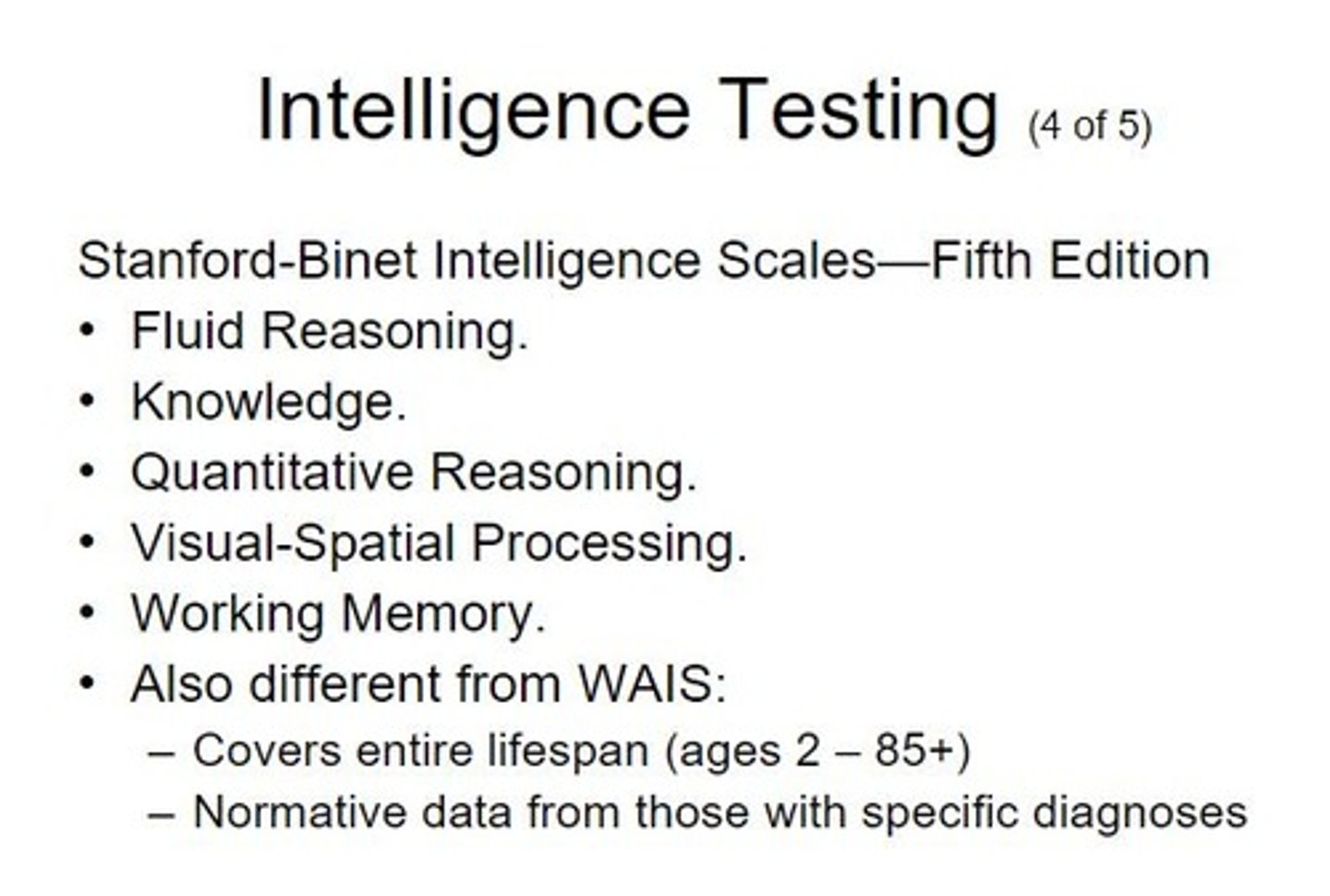
Additional Tests of Intelligence: Addressing Cultural Fairness
-Universal Nonverbal Intelligence Test-2 (UNIT-2)
A recently published intelligence test that was designed as entirely language-free in an attempt to maximize cultural fairness
Test Name: Universal Nonverbal Intelligence Test-2 (UNIT-2)
Language-free IQ test
Designed for cultural fairness
Age Range: 5-21 years
Interaction Mode:
Non-verbal interactions
Hand gestures for instructions
Main Categories:
Memory: Object MemorySpatial MemorySymbolic Memory
Reasoning: Cube Design, Mazes, Analogic Reasoning
Limitations:
Limited age range
Less extensive psychometric data
Less established than traditional IQ tests
Significance:
Highlights the need for culturally sensitive intelligence assessment tools in diverse societies.
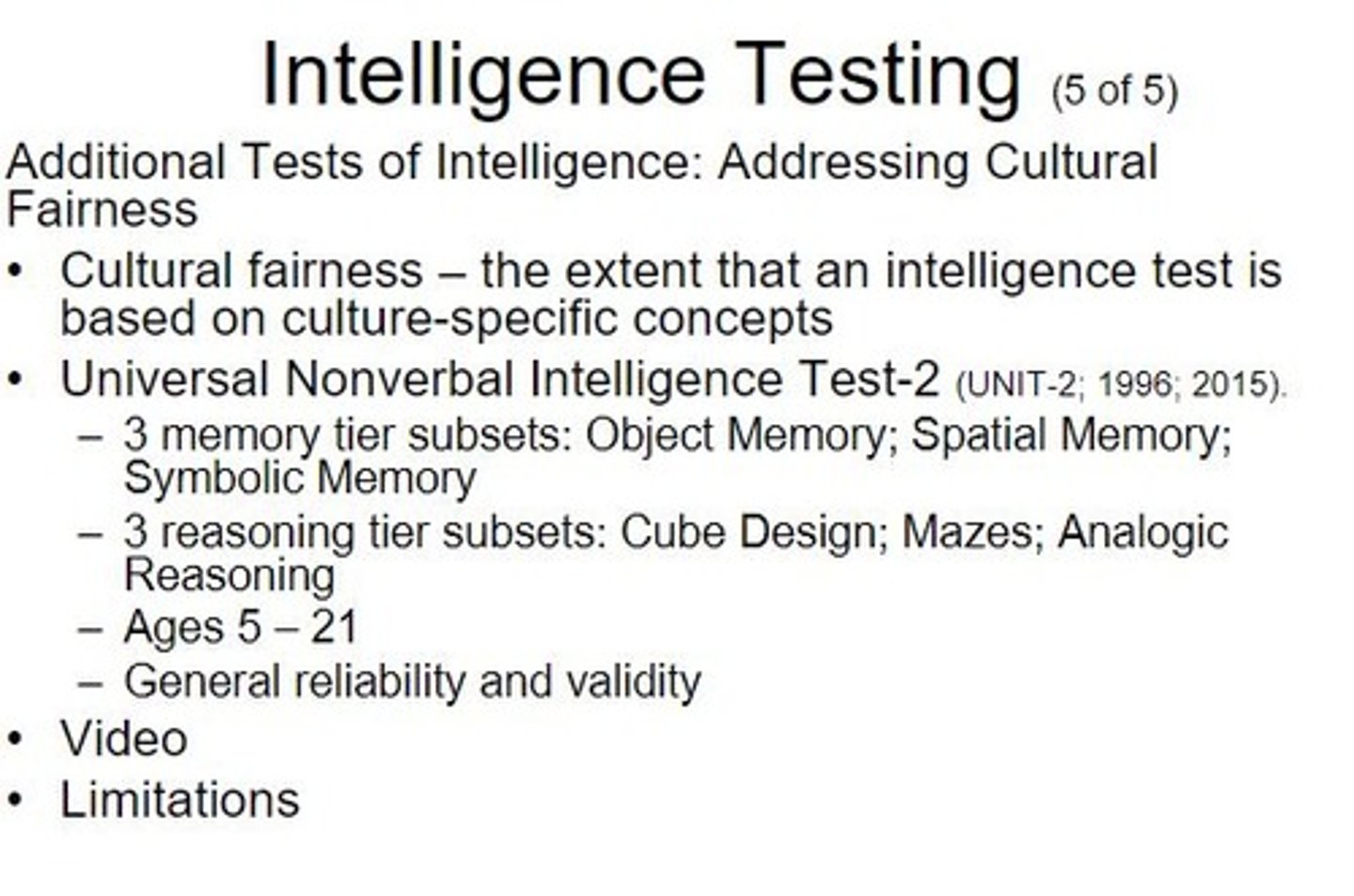
The WAIS is an appropriate test for a client who is ____ years old.
a) 4
b) 9
c) 89
d) 15
c) 89
The WAIS is designed for individuals aged 16 to 90 years old.
Charles Spearman is to intelligence is one thing, as ____________ is to intelligence is many things.
a) James Cattell
b) Emil Kraeplin
c) John Carroll
d) Louis Thurstone
d) Louis Thurstone
Which of the following best represents the hierarchical sequence in which WAIS scores should be interpreted?
a) Subtest scores, index scores, Full-Scale IQ
b) Index scores, Full-Scale IQ, subtest scores
c) Full-Scale IQ, index scores, subtest scores
d) Full-Scale IQ, subtest scores, index scores
c) Full-Scale IQ, index scores, subtest scores
Achievement Testing
Intelligence vs. Achievement:
Intelligence vs. Achievement:
Intelligence refers to a person’s cognitive capacity or what they can potentially accomplish intellectually.
Achievement measures what a person has actually accomplished, especially in academic subjects like reading or math.
DSM-5 Changes:
"Learning disability" has been renamed to "specific learning disorder" in DSM-5.
The definition now focuses on comparing a person’s achievement with expected levels for their age, instead of contrasting intelligence and achievement.
Psychological Reports:
Used by clinical psychologists to communicate test findings.
Reports should be accurate, address the reason for the referral, and be tailored to the intended audience.
Types of Achievement Tests:
Some focus on specific areas, like the KeyMath or Woodcock Reading Mastery Test.
Others are comprehensive, like the Woodcock-Johnson Tests of Achievement (WJ-ACH), the Kaufman Test of Educational Achievement (KTEA), and the Wechsler Individual Achievement Test (WIAT).
Many achievement tests pair with intelligence tests from the same company and are often co-normed.

Wechsler Individual Achievement Test—Fourth Edition (WIAT-IV):
The current edition of a prominent intelligence test for adults
is a comprehensive achievement test for clients aged 4 to 50 years.
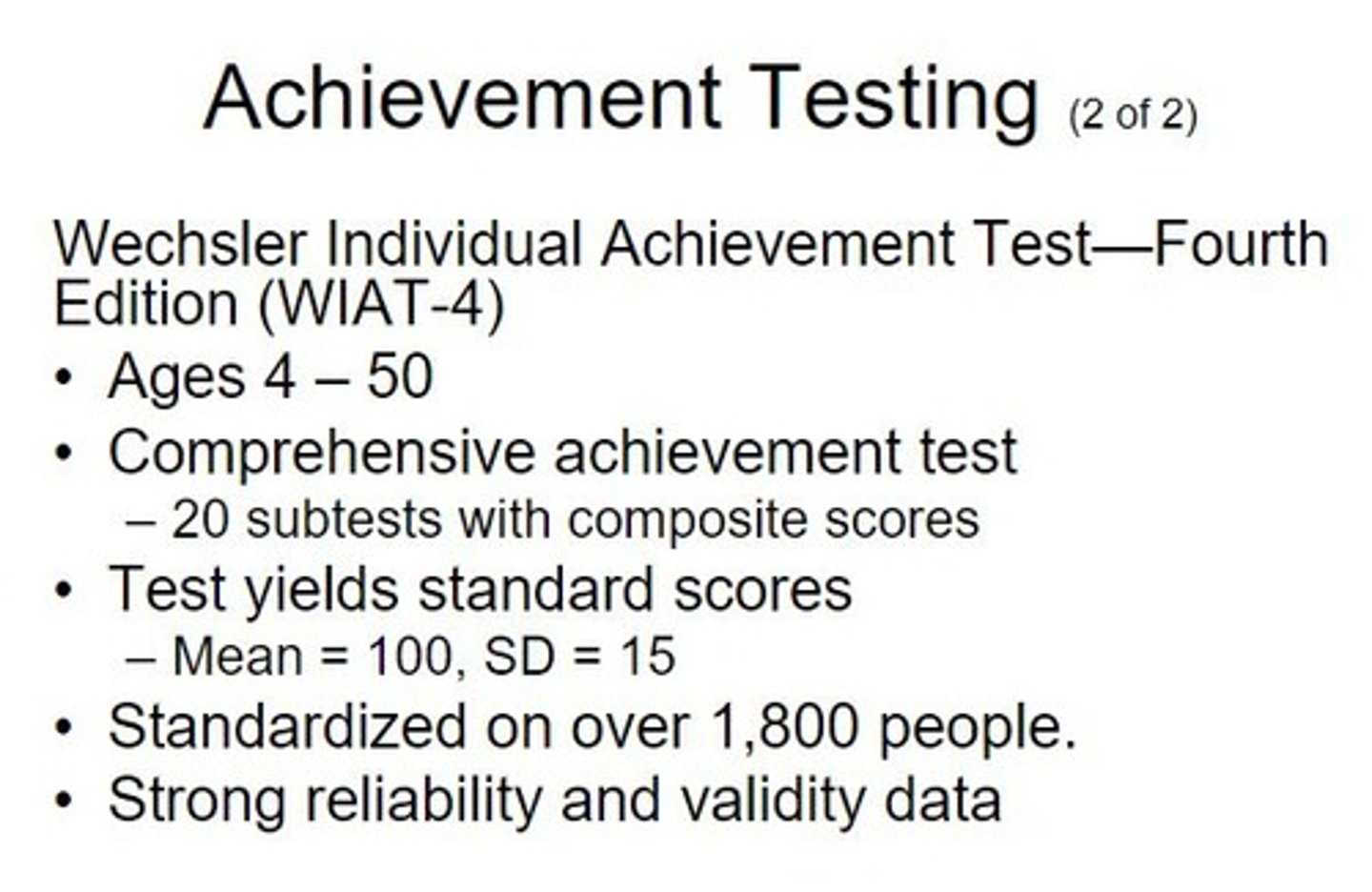
Review:
1. Spearman's Two-Factor Theory: Intelligence has a general factor (g-factor) common to all tasks and specific abilities (s-factor) unique to particular tasks.
Thurstone's Theory of Primary Mental Abilities: Intelligence consists of seven distinct abilities, such as verbal comprehension and spatial visualization.
2. Modern IQ tests reflect a hierarchical model.
3. when there's a significant discrepancy between an individual's academic achievement and their expected age, grade, or intellectual ability,
in 3 domains: reading, writing, or math
4. example: "Wechsler Individual Achievement Test (WIAT)."

Neuropsychological Testing
neuropsychological tests measure cognitive functioning or impairment of the brain and its specific components or structures
neuropsychological tests indicate how the brain is functioning.
Applications: Useful for assessing issues from head injuries, prolonged substance use, degenerative brain diseases, and for planning rehabilitation, accommodations, etc.
Evolution of Testing: Shifted from a fixed-battery phase to a more flexible-battery phase; customizing tests to individual needs.
Assessment Anxiety: Performance on tests can be influenced by anxiety; areas like attention and memory are especially vulnerable.
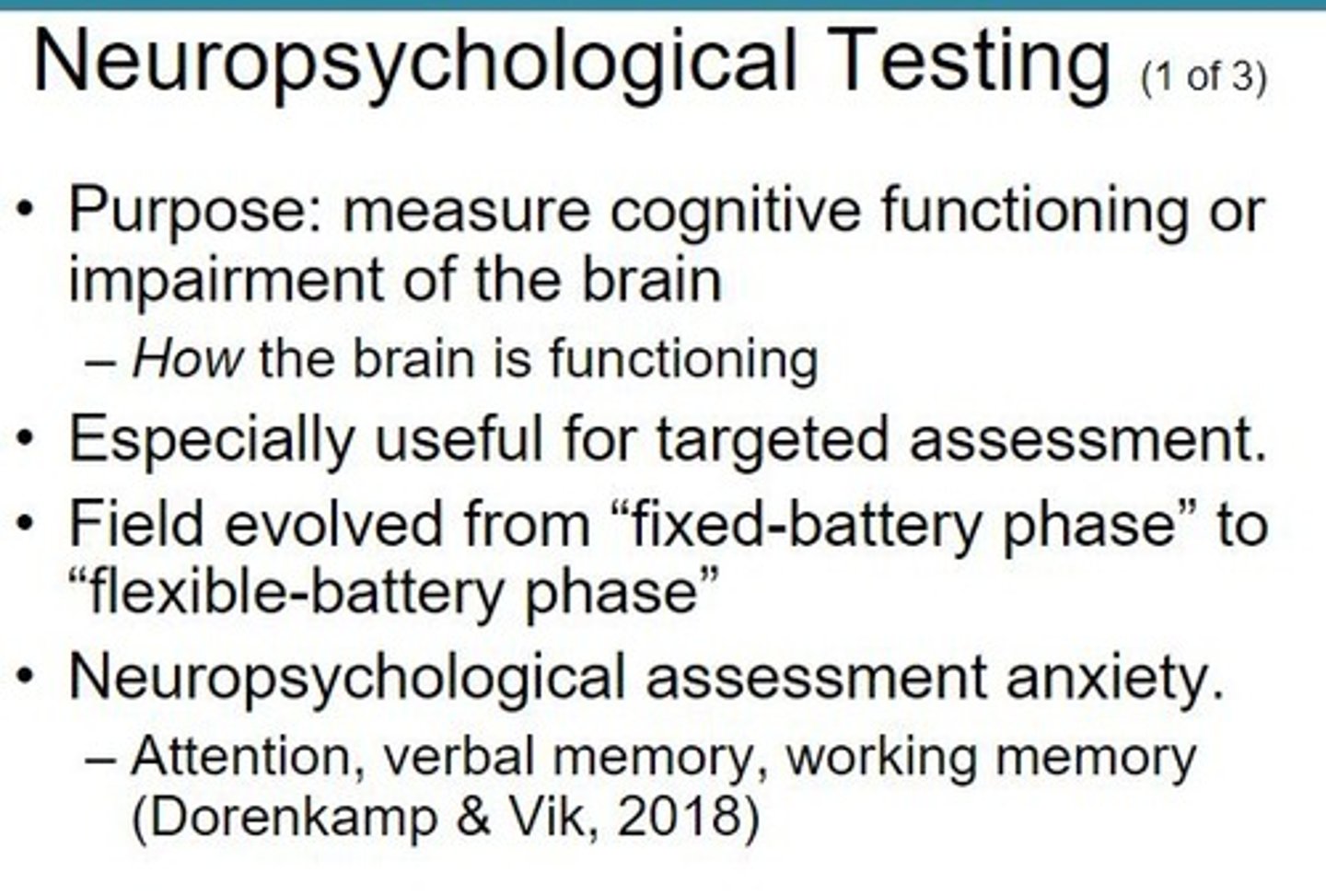
types of tests:
Types of Tests:
Full Batteries: Comprehensive assessments like the Halstead-Reitan Neuropsychological Battery (HRB) and the Luria-Nebraska Neuropsychological Battery (LNNB).
Brief Screens: Shorter evaluations, such as the Bender-Gestalt-II, Rey-Osterrieth Complex Figure Test, and the RBANS. They offer a rapid appraisal of neuropsychological functioning but might not be as detailed.
Full Neuropsychological Batteries: 3 tests
Halstead-Reitan Neuropsychological Battery (HRB): Eight tests, identify brain damage, assess cognitive impairments, and provide hypotheses about brain regions that may be affected.
Luria-Nebraska Neuropsychological Battery (LNNB): Emphasizes qualitative data and involves 12 scales. Slightly briefer than HRB and relies on qualitative observations from the examiner.
NEPSY-II: Designed specifically for children (ages 3-16), includes 32 subtests across six categories and offers flexibility in its usage.
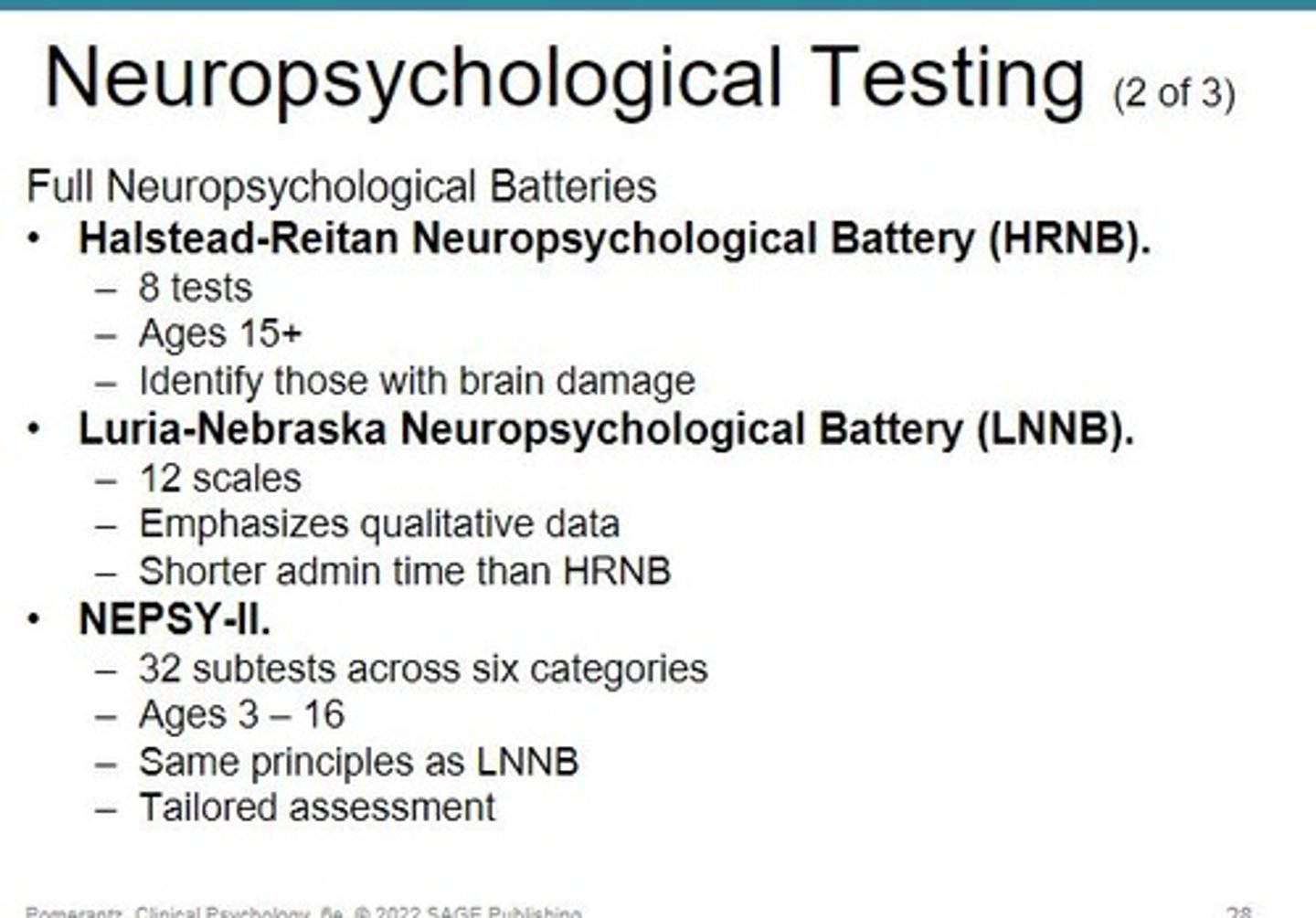
Brief Neuropsychological Measures
Bender-Gestalt-II: A simple copying task measuring visuoconstructive abilities. Takes about 6 minutes and is suitable for clients above 3 years.
Rey-Osterrieth Complex Figure Test: Another copying task but with a single, complex figure. It also includes a memory component.
RBANS: Offers a broader assessment including visuomotor abilities, verbal skills, attention, and visual memory. Takes 20-30 minutes.
WMS-IV: A memory test that assesses both visual and auditory memory. It evaluates immediate and delayed recall and has specific versions for older adults.

Sally undergoes psychological testing. Although her intelligence falls in the low average range, a discrepancy is still identified between her achievement and intelligence test scores (such that achievement falls significantly below expectations based on intelligence). This discrepancy will likely be the basis for a diagnosis of ______.
a) Intellectual disability
b) Giftedness
c) Specific learning disorder
d) Brain injury
c) Specific learning disorder
When there's a significant discrepancy between achievement and intelligence scores, where achievement falls notably below what one would expect based on the individual's intelligence, it often indicates a Specific Learning Disorder. This implies that the individual may have difficulty in a specific area of learning that isn't consistent with their overall intelligence.
I need to administer an IQ test to aclient who is suspected of being gifted.What test should I administer and why?
Stanford-Binet Intelligence Scales (SB5)
Explain how a neuropsychologicalevaluation is different from medicalprocedures (e.g., MRI, CT scan)
A neuropsychological evaluation assesses cognitive functions using standardized tests and tasks. It measures skills like memory, attention, problem-solving, and language.
medical procedures like MRI and CT scan capture structural or functional images of the brain to detect abnormalities or injuries.